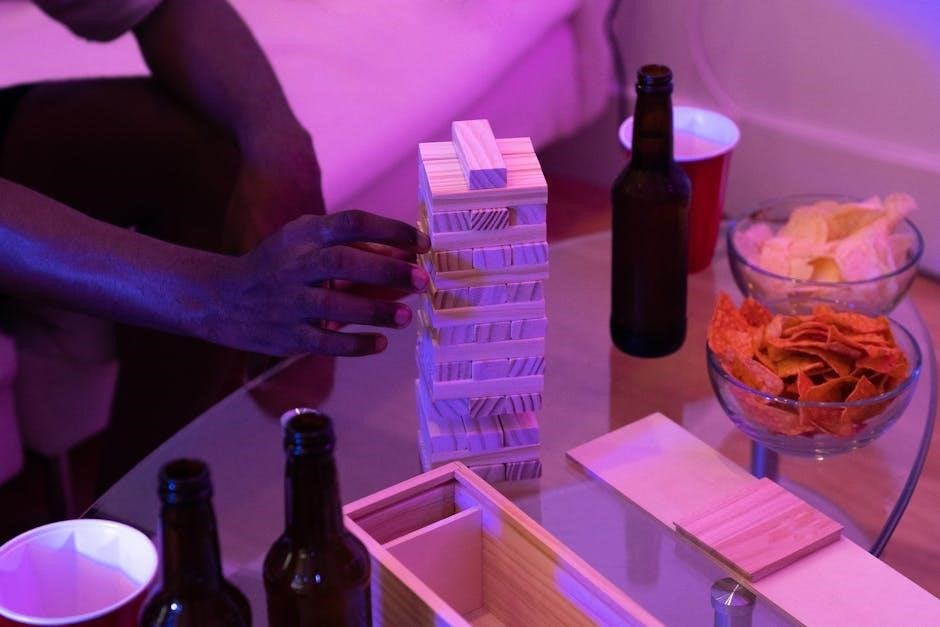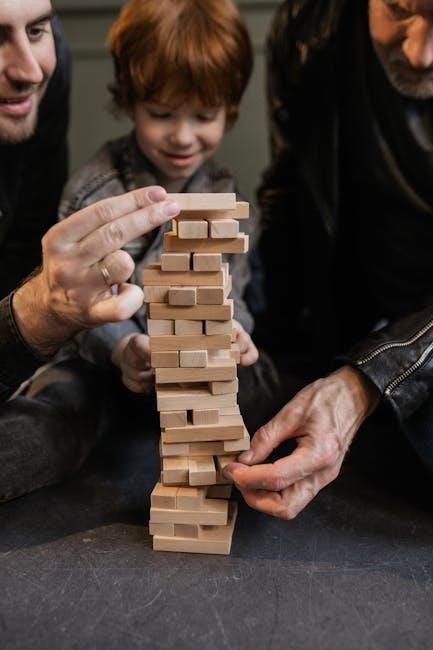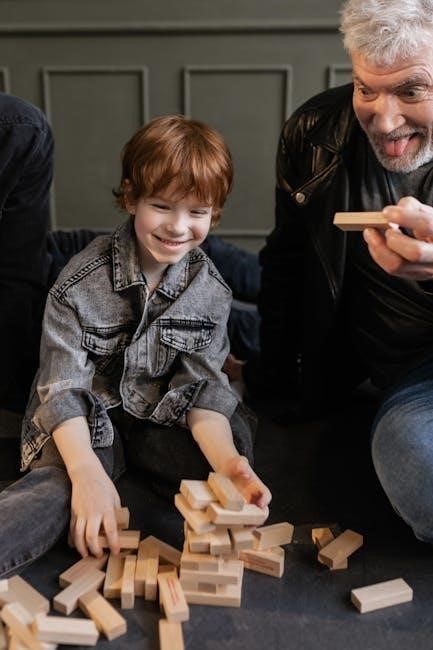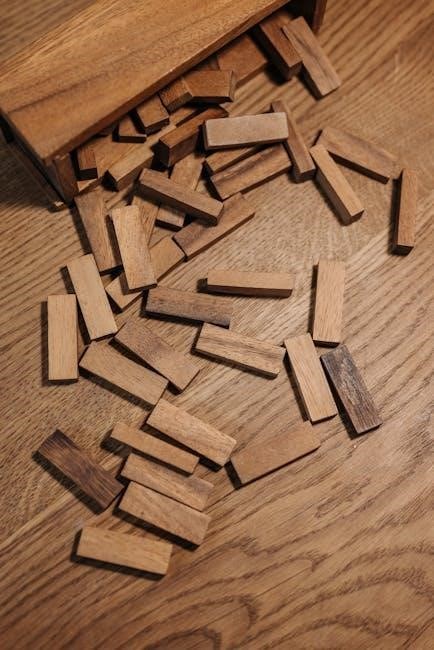Discover the official Jenga rules in the Hasbro Classic Jenga manual, available as a free PDF. This guide outlines the objective, setup, and gameplay, ensuring a fun and fair experience for all players while mastering the art of block-stacking strategy.
Overview of Jenga as a Classic Game
Jenga is a beloved classic game that combines skill, strategy, and suspense. Played with a tower made of wooden blocks, the game requires players to carefully remove pieces and stack them on top without causing the structure to collapse. Its simplicity and universal appeal make it a staple in many cultures, enjoyed by people of all ages. The game’s origins trace back to Swahili, where the name “Jenga” means “build.” With its iconic design and enduring popularity, Jenga has become a symbol of friendly competition and family fun, offering a unique blend of physical dexterity and mental focus in every turn.
Importance of Understanding the Rules
Understanding the rules of Jenga is crucial for ensuring fair play and maximizing enjoyment. The official PDF guide provides clear instructions on setup, gameplay, and winning conditions, helping players avoid disputes. By following the rules, participants can focus on developing their skills, such as precise block removal and strategic stacking. Proper adherence to the guidelines also ensures safety, preventing accidental tower collapses. Whether playing casually or competitively, knowing the rules enhances the experience, allowing everyone to appreciate the game’s balance of luck, strategy, and physical skill. This makes Jenga accessible and engaging for players of all ages and skill levels.

Basic Rules of Jenga
The game starts with a tower of 54 blocks in 18 layers of three. Players take turns removing one block and stacking it on top without causing a collapse. The last player to successfully place a block wins. The rules ensure a balanced mix of skill, strategy, and luck, making Jenga a timeless favorite for all ages. Adhering to these guidelines guarantees a fun and competitive experience for everyone involved. Understanding the basics is key to enjoying the game fully. The official PDF provides detailed instructions for setup and gameplay. Proper adherence ensures safety and fair play. Players must avoid causing the tower to fall. The game requires precision and focus. Following the rules enhances the overall experience. Jenga is simple yet challenging, making it accessible to everyone. The rules are designed to promote fair competition and enjoyment.
Objective of the Game
The primary objective of Jenga is to be the last player to successfully stack a block on top of the tower without causing it to fall. Players must carefully remove a single block from any level except the bottom two and place it on the highest level, ensuring the tower remains stable. The game requires a steady hand, strategic thinking, and a bit of luck. The winner is the player who makes the final valid move before the tower collapses. The objective emphasizes skill and precision, making Jenga a thrilling challenge for participants of all ages and skill levels. Mastery of this objective ensures victory and bragging rights among players.
Setup and Preparation
To begin, empty the 54 wooden blocks onto a flat surface and use the loading tray to construct the initial tower. Each layer must consist of three blocks placed side by side, with each subsequent layer oriented perpendicular to the one below it. This alternating pattern ensures stability. Once the tower is built, all players should gather around, and the youngest player typically goes first. The setup is complete when the tower is sturdy and ready for the first move. Proper preparation ensures fair and exciting gameplay, making it essential to follow these steps carefully before starting the game. Precision is key to a stable foundation.
Turn-Based Gameplay
Players take turns removing a single block from the tower and placing it on top. Each turn begins with a player carefully selecting a block from any level except the topmost completed layer. Once removed, the block must be placed on the highest level, ensuring it is positioned perpendicularly to the layer below it. The game progresses clockwise, with each player taking a turn until the tower falls. If the tower collapses during a player’s turn, they lose, and the game ends. The last player to successfully place a block without causing a collapse is declared the winner. Strategy and precision are crucial.

Understanding the Gameplay
Jenga involves building a tower and taking turns to remove blocks without causing it to fall. The game requires skill and strategy to ensure the tower’s stability.
How to Build the Initial Tower
To build the initial Jenga tower, start by placing three blocks side by side on a flat surface. Stack another layer of three blocks perpendicular to the first, aligning them neatly. Continue this process, alternating the direction of each layer to ensure stability. Each layer must be properly aligned to prevent the tower from leaning. The tower should stand upright with no blocks protruding unevenly. Once all 54 blocks are stacked, the tower is ready for gameplay. A stable base is crucial for a balanced and enjoyable game, so take care to align each layer carefully during the setup phase.
Removing Blocks and Stacking
Players take turns removing one block at a time from the tower, using only one hand. The chosen block must be carefully pulled out horizontally, ensuring minimal disturbance to the structure. Once removed, the block is placed on top of the tower, maintaining the same layer orientation as the previous one. Stacking must be done gently to avoid causing the tower to sway or collapse; Each move requires precision and balance, as the tower becomes increasingly unstable with each additional block. The goal is to stack the block without causing the tower to fall, testing both skill and nerve throughout the game.
Legal Moves and Restrictions
Players must adhere to specific rules when removing and stacking blocks. Only one block can be removed per turn, using one hand, and it must be taken from above the base layer. Blocks cannot be moved or relocated once placed on top. If a block is removed but not immediately placed, the turn continues until it is stacked. Any block that falls during removal or stacking results in an illegal move. Illegal moves, such as using both hands or destabilizing the tower intentionally, can lead to penalties, as outlined in the official Jenga rules PDF. Adhering to these restrictions ensures fair play and maintains the game’s integrity.

Winning Conditions and Penalties
The last player to successfully stack a block without causing the tower to fall is declared the winner. If a player makes the tower collapse, they lose immediately.
How to Win the Game
The objective of Jenga is to be the last player to successfully stack a block without causing the tower to fall. The game concludes when the tower collapses during a player’s turn, resulting in their loss. To win, players must carefully remove blocks from the lower levels and place them on top, maintaining balance. The last player to place a block before the tower falls is declared the winner. This requires precision, patience, and strategic planning to outlast opponents. The game ends immediately if the tower collapses, making it a thrilling test of skill and nerve for all participants involved.
Consequences of Making the Tower Fall
If a player causes the tower to fall during their turn, they immediately lose the game. The collapsing of the tower signals the end of the game, and the player responsible is declared the loser. Additionally, the losing player is often tasked with setting up the tower for the next round, giving them a chance to redeem themselves. This consequence adds an extra layer of tension, as players must balance risk and precision to avoid being the one who makes the tower fall. The fear of losing ensures that players approach each move with caution and strategic intent.
Advanced Strategies and Tips
Mastering Jenga requires a steady hand, strategic thinking, and psychological insight. Players can improve by practicing precision, studying opponents’ moves, and maintaining focus under pressure to ensure balance and stability in the tower.
Mastering the Technique of Block Removal
Mastering block removal in Jenga involves precision and patience. Players should gently pull blocks using a steady hand, often starting from the middle or corners of the tower. Tapping the tower to identify loose blocks can help in making informed moves. It’s crucial to maintain balance by keeping the tower centered and avoiding sudden movements. Experienced players also study the structure to determine the safest blocks to remove, minimizing the risk of collapse. Over time, practice enhances the tactile skill needed to execute smooth, controlled extractions, making each move a strategic step toward victory.
Psychological Aspects of the Game
Jenga is as much a mental challenge as it is physical. Players must maintain focus and composure under increasing tension. The pressure to avoid causing a collapse can heighten anxiety, while the thrill of successful moves boosts confidence. Strategic thinking is essential, as each decision impacts the game’s outcome. The unpredictability of the tower’s stability keeps players engaged, testing their patience and nerve. Mastering Jenga requires balancing risk and caution, making it a game that sharpens mental acuity and emotional control. The psychological elements add depth, transforming it into a test of both skill and mindset for players of all ages.
Team Play and Collaboration
While traditionally a competitive game, Jenga can also be enjoyed in team play, fostering collaboration and strategy. Teams work together to remove and stack blocks, sharing the tension and excitement. Communication is key, as players must coordinate their moves to maintain the tower’s stability. This cooperative approach enhances the social aspect of the game, encouraging teamwork and mutual problem-solving. Whether splitting tasks or discussing the best blocks to remove, team play adds a new dynamic, making Jenga a fun and bonding experience for groups. The shared goal of keeping the tower standing strengthens camaraderie and shared responsibility for success or failure.

Variations and House Rules
Explore various Jenga editions and house rules to customize gameplay. From Jenga Xtreme to themed versions, adapt the game for different ages and preferences, enhancing fun and challenge.
Alternative Ways to Play Jenga
Explore creative twists on the classic game with Jenga Xtreme, featuring angled blocks for added instability. Themed editions like Super Mario Jenga introduce unique challenges, blending strategy with pop culture fun. For team-based excitement, divide players into groups to collaborate on stabilizing the tower. House rules can also mix things up, such as allowing only one hand or setting time limits for moves. These variations keep the game fresh and engaging, catering to diverse preferences and age groups while maintaining the core suspense and skill required to master Jenga.
Custom Rules for Different Age Groups
Adapt Jenga to suit various ages with tailored rules. For younger children, simplify by allowing block removal with both hands or skipping the bottom layer restriction. Older kids can face challenges like timed turns or penalties for dropping blocks. Adults can enhance gameplay with team collaborations or themed editions like Super Mario Jenga. Safety is key, especially for toddlers—use soft blocks or limit height. These adjustments ensure fun and fairness for all ages, keeping the game dynamic and enjoyable while maintaining its core excitement and skill-building aspects. Customizing rules helps make Jenga accessible and engaging for every player.

Safety Precautions
Ensure a stable playing environment, avoid overreaching, and supervise children to maintain safety and prevent accidents during gameplay.
Ensuring a Safe Playing Environment
Creating a safe space for playing Jenga is essential to prevent accidents. Ensure the playing area is clear of obstacles and breakable items. Use a sturdy, flat surface for the tower to minimize the risk of it tipping over. Avoid overreaching or using excessive force, as this can lead to unintended collapses. Supervise children during gameplay to teach proper handling of the blocks. Encourage players to maintain focus and avoid distractions while removing or stacking blocks. By following these guidelines, you can enjoy Jenga while keeping everyone safe and ensuring a fun experience for all participants.

Exploring Different Editions
Discover various Jenga editions, such as Jenga Xtreme and themed versions like Super Mario or Star Wars, each offering unique twists on the classic game for enhanced fun and variety.
Jenga Xtreme and Other Variants
Jenga Xtreme introduces angled blocks, adding a new level of challenge to the classic game. Players must adapt to uneven structures, making each move even more precarious. Other variants, such as Super Mario and Star Wars themed editions, bring iconic characters and designs to the traditional gameplay. These special editions often include custom rules or themed blocks, enhancing the fun. For instance, Jenga Super Mario combines tower-building with Mario-themed challenges, while Jenga Star Wars features blocks inspired by the franchise. These variations keep the game fresh and exciting for fans of all ages and backgrounds.
Themed Editions of the Game
Themed editions of Jenga, such as Super Mario and Star Wars, bring unique twists to the classic gameplay. These editions feature custom-designed blocks and artwork inspired by popular franchises, allowing fans to engage with their favorite characters while playing. For example, Jenga Super Mario includes Mario-themed blocks and special power-ups, adding a new layer of strategy. Similarly, Jenga Star Wars incorporates iconic imagery from the franchise, making it a must-have for fans. These themed versions retain the core mechanics of the game while offering a fresh and immersive experience that appeals to both casual players and enthusiasts of the respective franchises.

Cultural Impact and History
Jenga, derived from the Swahili word “kujenga,” meaning “to build,” has become a cultural icon, symbolizing skill and strategy. Its origins trace back to a simple wooden block game, evolving into a global phenomenon enjoyed by diverse audiences, as highlighted in the Jenga rules PDF. The game’s universal appeal lies in its ability to transcend age and cultural barriers, making it a staple in many households and popular media, as noted in various online resources and the Hasbro manual.
Origins of the Game
Jenga, meaning “to build” in Swahili, traces its origins to Kenya, where it was created by Kenyan-born David Rhoda in 1971. Initially handmade for family use, the game gained popularity after being licensed to Kenner in 1981. The name reflects its Swahili roots, emphasizing construction and skill. Hasbro later acquired the rights, further popularizing the game globally. The game’s simplicity and universal appeal have made it a cultural icon, transcending age and geography, as detailed in the Jenga rules PDF and historical accounts from Hasbro and other sources.
Jenga in Popular Culture
Jenga has become a cultural phenomenon, appearing in films, TV shows, and music, symbolizing suspense and skill. Themed editions, like Super Mario and collaborations with LEGO, reflect its broad appeal. Its inclusion in Hasbro Family Game Night on XBLA highlights its digital presence. Jenga’s simplicity and tension make it a favorite in media, often used to depict nerve-wracking challenges. The game’s iconic status is further evident through its mention in various pop culture references, from comedy sketches to competitive events like Monopoly KHL, showcasing its enduring relevance and universal charm, as detailed in the Jenga rules PDF and cultural analyses.

Resources and Downloads
Access the official Jenga rules PDF on Hasbro’s website, providing detailed instructions for setup, gameplay, and variations; This 10-page manual ensures clarity for players of all skill levels.
Official Jenga Rules PDF
The official Jenga rules PDF is available on Hasbro’s website, offering a comprehensive guide to the game. This 10-page document covers setup, gameplay, and winning conditions, ensuring players understand the rules clearly. It includes detailed instructions for building the tower, removing blocks, and penalties for causing it to fall. The PDF also outlines variations and house rules, allowing players to customize their experience. Whether you’re a beginner or an experienced player, this resource is essential for mastering the game and resolving disputes during play. Visit the Hasbro website to download your copy today and enjoy a fair and fun game with friends and family. The PDF is a valuable tool for ensuring everyone plays by the same rules, making it a must-have for any Jenga enthusiast. By referring to this official guide, you can enhance your gameplay and appreciate the strategic depth of Jenga. Don’t miss out on the opportunity to elevate your skills with the official rules at your fingertips.
Where to Find Instruction Manuals
Instruction manuals for Jenga can be easily found online through various sources. The official Hasbro website provides a free PDF version of the Classic Jenga manual, which includes detailed rules and setup instructions. Additionally, websites like ManualsLib and game forums often host downloadable versions of the manual. For specific editions, such as Jenga Xtreme or themed versions, check the official Hasbro product pages or retailer websites. These resources ensure you have access to the most accurate and up-to-date guidelines for gameplay, helping you enjoy Jenga with confidence and clarity.
Mastery of Jenga requires practice and understanding of its rules. The official PDF guide provides comprehensive insights, ensuring a fun and strategic gameplay experience for all players.
Final Thoughts on Mastering Jenga
Mastering Jenga requires a blend of skill, strategy, and patience. The game demands precise movements and a deep understanding of the tower’s balance. Players must analyze each block’s position and predict potential weaknesses. Regular practice enhances hand stability and decision-making. The psychological aspect of pressuring opponents adds another layer of complexity; To excel, study the official Jenga rules and experiment with advanced techniques. The official PDF guide from Hasbro offers detailed insights, ensuring a comprehensive grasp of the game. Whether playing casually or competitively, Jenga remains a timeless challenge that rewards focus and creativity, making it a beloved classic across generations.

About the Author
The author is a gaming enthusiast with a deep passion for analyzing and explaining rules and strategies for classic games like Jenga. Drawing from various sources, including the Hasbro Classic Jenga manual and online resources, the author provides clear, concise guides to ensure players of all skill levels can enjoy the game. With a focus on accuracy and accessibility, the author bridges the gap between official PDF instructions and practical gameplay tips, helping readers master Jenga’s unique blend of skill and strategy. Their work is dedicated to fostering a community of players who appreciate the timeless appeal of this iconic game.
